Modeling Kapitza resistance of two-phase composite material
- verfasst von
- Bo He, Bohayra Mortazavi, Xiaoying Zhuang, Timon Rabczuk
- Abstract
We predict the thermal conductivity of polymer-matrix composites accounting for the interface conductance. We also study the influence of different fillers, i.e. spherical, cylindrical and plate-like fillers (fullerene, carbon nanotubes and graphene sheets) with different ratios (plate diameter to plate thickness and length to diameter ratios for plate-like and cylindrical fillers, respectively). Therefore, we exploit computational homogenization based on representative volume elements (RVEs). We also compare the results to analytical homogenization methods, i.e. the Maxwell–Garnett type effective medium approximation (MG-EMA) and the Mori–Tanaka method; the first method accounts for the interface conductance. As expected, the highest increase in the thermal conductivity is achieved for the cylindrical fillers due to the highest surface-to-volume ratio. Simulations at the nano- and micro-scale reveal that the interface conductance looses relevance at the larger length scales while it has a substantial influence at the nano-scale. Furthermore, we demonstrate that functionalization and increasing the number of segregated graphene sheets can significantly increase the thermal conductivity. Our 3D finite element model reveals that Maxwell–Garnett type effective medium approximation (MG-EMA) and the Mori–Tanaka method cannot be considered as accurate modeling approaches to predict the thermal conductivity of nanocomposite materials. Our investigation therefore highlights the need for more elaborated models in order to more reliably predict the heat transfer of the nanocomposite structures.
- Organisationseinheit(en)
-
Institut für Kontinuumsmechanik
- Externe Organisation(en)
-
Tongji University
Bauhaus-Universität Weimar
Ton Duc Thang University
- Typ
- Artikel
- Journal
- Composite Structures
- Band
- 152
- Seiten
- 939-946
- Anzahl der Seiten
- 8
- ISSN
- 0263-8223
- Publikationsdatum
- 15.06.2016
- Publikationsstatus
- Veröffentlicht
- Peer-reviewed
- Ja
- ASJC Scopus Sachgebiete
- Keramische und Verbundwerkstoffe, Tief- und Ingenieurbau
- Elektronische Version(en)
-
https://doi.org/10.1016/j.compstruct.2016.06.025 (Zugang:
Geschlossen)


